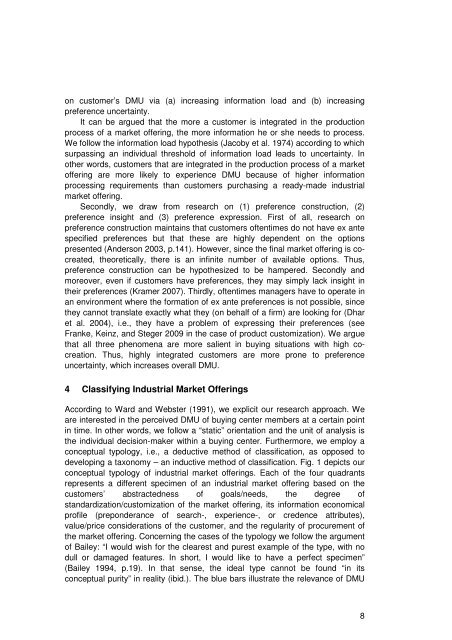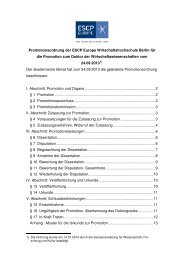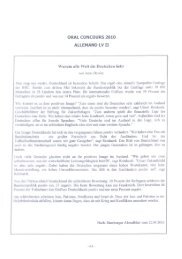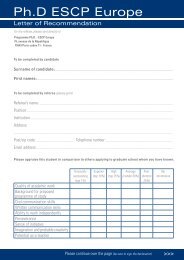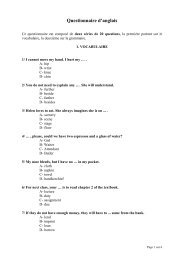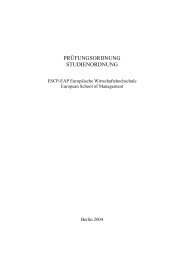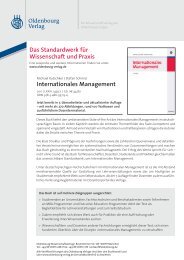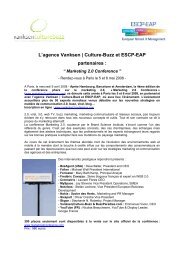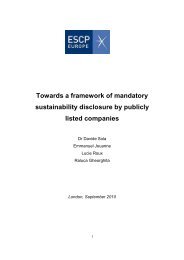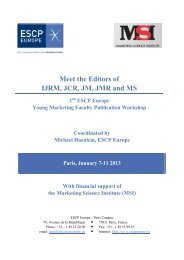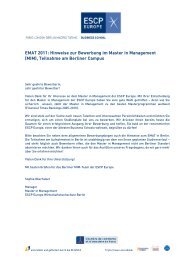WP 53_Jacob_neu - ESCP Europe Business School
WP 53_Jacob_neu - ESCP Europe Business School
WP 53_Jacob_neu - ESCP Europe Business School
You also want an ePaper? Increase the reach of your titles
YUMPU automatically turns print PDFs into web optimized ePapers that Google loves.
on customer’s DMU via (a) increasing information load and (b) increasing<br />
preference uncertainty.<br />
It can be argued that the more a customer is integrated in the production<br />
process of a market offering, the more information he or she needs to process.<br />
We follow the information load hypothesis (<strong>Jacob</strong>y et al. 1974) according to which<br />
surpassing an individual threshold of information load leads to uncertainty. In<br />
other words, customers that are integrated in the production process of a market<br />
offering are more likely to experience DMU because of higher information<br />
processing requirements than customers purchasing a ready-made industrial<br />
market offering.<br />
Secondly, we draw from research on (1) preference construction, (2)<br />
preference insight and (3) preference expression. First of all, research on<br />
preference construction maintains that customers oftentimes do not have ex ante<br />
specified preferences but that these are highly dependent on the options<br />
presented (Anderson 2003, p.141). However, since the final market offering is cocreated,<br />
theoretically, there is an infinite number of available options. Thus,<br />
preference construction can be hypothesized to be hampered. Secondly and<br />
moreover, even if customers have preferences, they may simply lack insight in<br />
their preferences (Kramer 2007). Thirdly, oftentimes managers have to operate in<br />
an environment where the formation of ex ante preferences is not possible, since<br />
they cannot translate exactly what they (on behalf of a firm) are looking for (Dhar<br />
et al. 2004), i.e., they have a problem of expressing their preferences (see<br />
Franke, Keinz, and Steger 2009 in the case of product customization). We argue<br />
that all three phenomena are more salient in buying situations with high cocreation.<br />
Thus, highly integrated customers are more prone to preference<br />
uncertainty, which increases overall DMU.<br />
4 Classifying Industrial Market Offerings<br />
According to Ward and Webster (1991), we explicit our research approach. We<br />
are interested in the perceived DMU of buying center members at a certain point<br />
in time. In other words, we follow a “static” orientation and the unit of analysis is<br />
the individual decision-maker within a buying center. Furthermore, we employ a<br />
conceptual typology, i.e., a deductive method of classification, as opposed to<br />
developing a taxonomy – an inductive method of classification. Fig. 1 depicts our<br />
conceptual typology of industrial market offerings. Each of the four quadrants<br />
represents a different specimen of an industrial market offering based on the<br />
customers’ abstractedness of goals/needs, the degree of<br />
standardization/customization of the market offering, its information economical<br />
profile (preponderance of search-, experience-, or credence attributes),<br />
value/price considerations of the customer, and the regularity of procurement of<br />
the market offering. Concerning the cases of the typology we follow the argument<br />
of Bailey: “I would wish for the clearest and purest example of the type, with no<br />
dull or damaged features. In short, I would like to have a perfect specimen”<br />
(Bailey 1994, p.19). In that sense, the ideal type cannot be found “in its<br />
conceptual purity” in reality (ibid.). The blue bars illustrate the relevance of DMU<br />
8


